
The transport system of Finland is well-developed. Factors affecting traffic include the sparse population and long distance between towns and cities, and the cold climate with waterways freezing and land covered in snow for winter.
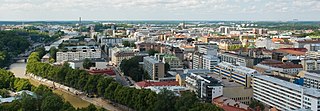
Turku is a city in Finland and the regional capital of Southwest Finland. It is located on the southwestern coast of the country at the mouth of the River Aura. The population of Turku is approximately 206,000, while the metropolitan area has a population of approximately 315,000. It is the 6th most populous municipality in Finland, and the third most populous urban area in the country after Helsinki and Tampere.

The Royal Academy of Turku or the Royal Academy of Åbo was the first university in Finland, and the only Finnish university that was founded when the country still was a part of Sweden. It was founded in 1640. In 1809, after Finland became a grand duchy within the Russian Empire, it was renamed the Imperial Academy of Turku. In 1828, after the Great Fire of Turku, the institution was moved to Helsinki, in line with the relocation of the capital of the grand duchy. It was finally renamed the University of Helsinki when Finland declared independence in 1917.

The Aura River is a river in south-western Finland. It originates in Oripää, and it flows through Pöytyä, Aura, Lieto, and ultimately the city of Turku before discharging into the Archipelago Sea. The waters of the Aura river are brown. The total length of the river is about 70 kilometres (43 mi), and it contains eleven rapids, the biggest of which is Nautelankoski at Lieto. The reserve tap water for Turku Region is drawn from the Aura, the city's secondary waterworks being situated by the Halinen rapids.
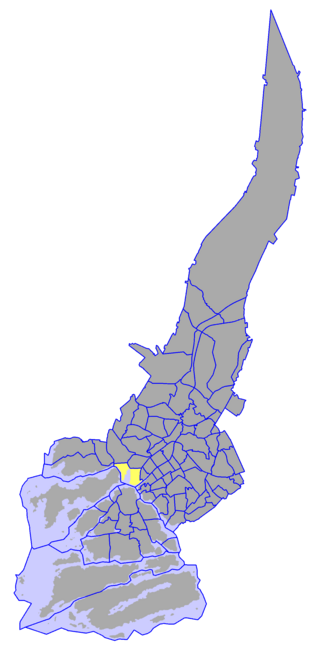
The Port of Turku is a port located in the south-west of Finland, where the mainland meets the beginning of the Turku archipelago. Sited within Finland's sixth largest city, the port principally handles traffic between Turku and the Swedish capital of Stockholm and the enclaved Åland.

European route E18 runs between Craigavon in Northern Ireland and Saint Petersburg in Russia, passing through Scotland, England, Norway, Sweden and Finland. It is about 1,890 kilometres in length.

The Finnish railway network consists of a total track length of 9,216 km (5,727 mi). The railways are built with a broad 1,524 mm track gauge, of which 3,249 km (2,019 mi) is electrified. Passenger trains are operated by the state-owned enterprise VR that runs services on 7,225 km (4,489 mi) of track. These services cover all major cities and many rural areas, though the coverage is less than the coverage provided by the bus services. Most passenger train services originate or terminate at Helsinki Central railway station, and a large proportion of the passenger rail network radiates out of Helsinki. VR also operates freight services. Maintenance and construction of the railway network itself is the responsibility of the Finnish Rail Administration, which is a part of the Finnish Transport Agency. The network consists of six areal centres, that manage the use and maintenance of the routes in co-operation. Cargo yards and large stations may have their own signalling systems.

Åboland is a sub-region in the archipelago of the Southwest Finland region in south-western Finland.
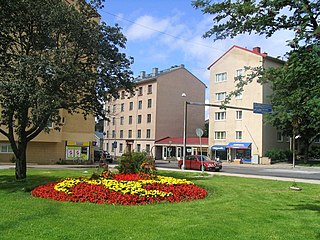
The IV District, also known as Martti, is one of the central districts of Turku, Finland. It is located on the east side of the river Aura, between Tervahovinkatu in the west and Betaniankatu and Martinkatu in the east. The district is one of the smallest in Turku, and is centred on the Martinkirkko church, named after the reformer Martin Luther. Martti is also one of the most expensive areas to live in Turku.
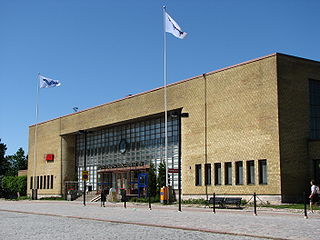
Turku Central Station is a railway station in the VII District of Turku, Finland. It has VR services to Helsinki and towards Joensuu. The station serves approximately a million passengers annually.

Pasila station is a railway station in Helsinki, Finland, approximately 3.5 kilometres (2.2 mi) north of Helsinki Central. It is the second busiest railway station in Finland, after Helsinki Central, and takes up a large part of the district of Pasila. The station was first opened in 1862 along the Finnish Main Line. The current station building opened in 2019.

Haarla is a district and a suburb of the city of Turku, in Finland. It is located in the southern part of the island of Hirvensalo, off the city's coastline. The bridge between Hirvensalo and Satava is located in Haarla.

Lauttaranta is a district and a suburb of the city of Turku, in Finland. It is located in the northern part of the island of Hirvensalo, off the city's coastline. The only bridge between Hirvensalo and the mainland is located in Lauttaranta, connecting it to the district of Pihlajaniemi.
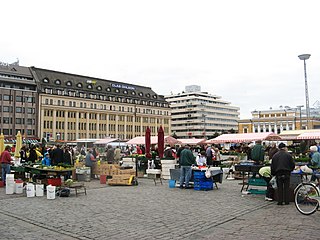
The Market Square is a city square in the city of Turku, in Finland. It is located in the city's VI District, and is generally considered the city's central square. It hosts a lively market on weekdays, and there are several cafés and restaurants on the square.

Puutori is a market square in the city centre of Turku, Finland. It measures at approximately 100 by 40 metres. It is bordered by Aninkaistenkatu/Aningaisgatan, Maariankatu/Mariegatan, Brahenkatu/Brahegatan and Sibeliuksenkatu/Sibeliusgatan. Today, it has no regular market square activity but Puutorin puolesta ry organises different events there each year. Located at one end of the square are Ystävyydenpuisto and Wäinö Aaltonen's statue Kun ystävyyssuhteet solmitaan, which was designed in 1955 in honour of the friendship between Turku and Göteborg. There are also small cafés and shops surrounding Puutori, as well as a pet store.

The Old Great Square is a medieval market square located in the city centre of Turku, Finland. It is located in the II District in very close proximity to Turku Cathedral. The area was the administrative and commercial centre of Turku since the founding of the city in the 13th century up until the Great Fire of Turku.

The Myllysilta is a steel girder bridge crossing the Aurajoki in the middle of the city of Turku in Finland. The bridge was opened on 19 September 2011. Only two of four lanes were first in use, the bridge was totally completed on 29 November 2011, even though some landscaping and stone work were completed in 2012. The bridge connects Turku's IV district to the VII district, and has four westbound lanes, and a sidewalk on northern side. It is a one-way-route from east to west, while the nearby Martinsilta bridge goes west to east.

Trams in Finland date from a horse-drawn Turku tramway network, which opened in 1890. Electric tramway traction started in Finland in 1900 with the introduction of electric trams in Helsinki, and the last horse-drawn trams were withdrawn from operation in 1917. Although there were three Finnish tramway networks between 1912 and World War II, by 1972 the number of networks had dwindled to just one, that of Helsinki, which remained Finland's only tramway network for almost 50 years. However, in August 2021, a light rail line was opened to the public in Tampere. There have also been proposals to set up tram or light rail networks in some other cities. As of 2021, the most concrete such plans are in Turku.

Kitula is a village in Suomusjärvi, Salo, in Southwest Finland, along regional road 110. It is the administrative center of the former municipality of Suomusjärvi, where local services such as a grocery store, a hardware store, a library, a primary school, a sports field and a refrigeration station for fuel distribution are located. Most of the services are between Urheilutie and Helsingintie.

The Turku–Toijala railway is a 1,524 mm railway in Finland. Running through the regions of Southwest Finland, Kanta-Häme and Pirkanmaa, it connects the junction stations of Turku and Toijala in the southwest–northeast direction.




















